“An hourglass to remind us…that as long as we take care of our environment, the energy will never run out.”
-Santiago Muros Cortés
The Solar Hourglass
First Place winner to the 2014 Land Art Generator Initiative Copenhagen design competition
Artist: Santiago Muros Cortés
Artist Location: Buenos Aires, Argentina
Energy Technologies: concentrated solar power (thermal beam-down tower with heliostats)
See bottom of this post for more information about the MASDAR precedent for this technology.
Annual Capacity: 6,000 MWh
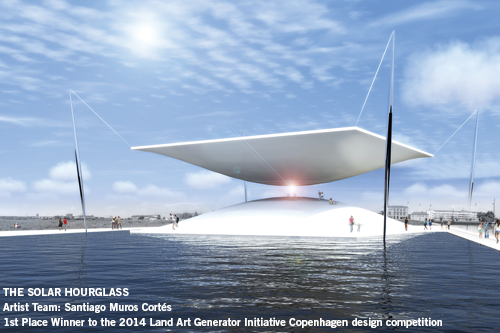
Rather than using sand to measure time, the Solar Hourglass uses the power of the sun to electrify hundreds of homes while providing a breathtaking setting for inspiration and relaxation. The installation consists of an upper and a lower bulb. Dozens of people can gather on the bottom bulb during the day, sheltered by the shade of the top bulb.
The project works as a solar central receiver, consisting of an arrangement of small flat mirrors that concentrate their reflection of solar energy on a tank holding a heating medium. Sun-tracking mirrors (heliostats) on top of the upper bulb reflect solar heat onto a cone-shaped set of smaller mirrors that concentrate these reflections and direct them down the neck of the installation.
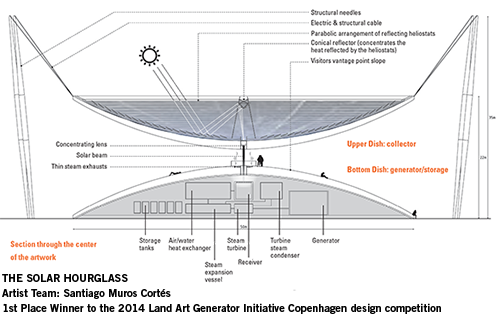
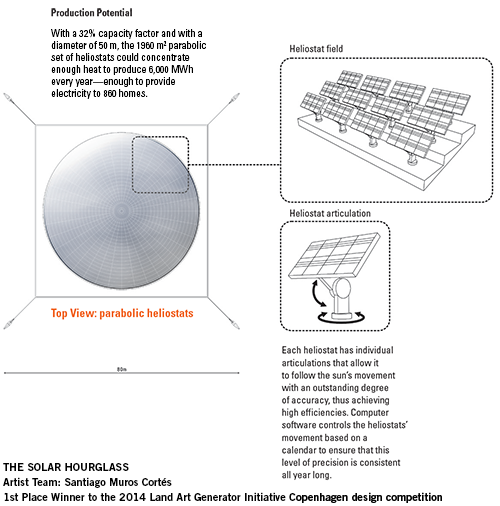
The concentrated beam of solar heat then reaches a receiver containing heat transfer fluid (HTF) of molten nitrate salt, which is heated to temperatures over 600°C. The HTF is conveyed through a heat exchanger where water is turned into steam to run a turbine generator. A small percentage of the steam produced is released back into the neck of the hourglass, thus making the solar beam visible to the public.
The higher heat capacity of the molten salt allows for the system to store heat and produce energy during cloudy weather or even at night.
All the energy production and transformation components are hidden inside the bottom bulb and inaccessible to the general public, making it safe for public engagement.
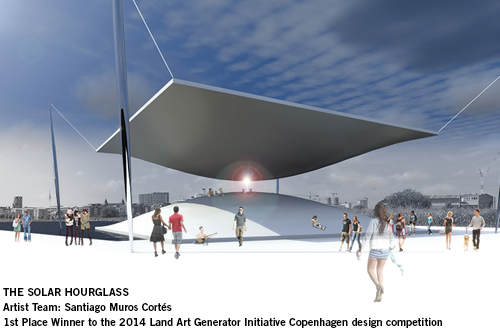
At night, the beam turns off, and the thin layer of OLED (organic light-emitting diode) that covers the installation, lights up on the surface of both bulbs, transforming the hourglass into a pair of elegantly curved planes that shine on the edge of Refshaleøen.
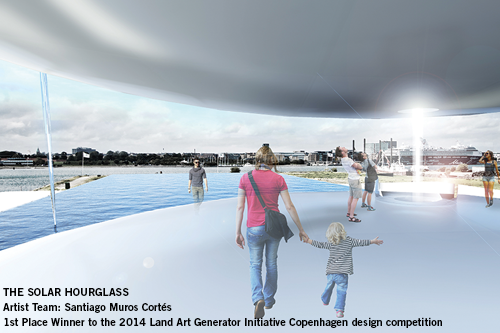
The Solar Hourglass reminds us that energy is just as precious and fleeting as time, and thus we should take care of it, appreciate it, and not waste it. The project aims to send an optimistic message to those who visit: we still have time to make things right with the environment, and if we act now, it is not yet too late.
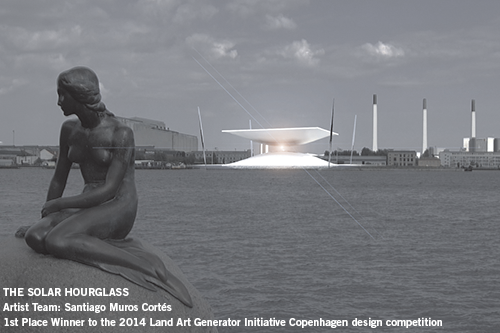
More about the technology: The solar thermal beam-down tower technology has been prototyped and tested by Masdar in Abu Dhabi.
It’s an advancement in concentrated solar power (CSP) tower technology, which collects the sun’s energy over a wide surface area and focuses it onto a single point by using sun-tracking mirrors. In conventional CSP towers, the collector is located at the top of the tower. Water is pumped up and through the collector to generate steam. In beam-down towers, the sunlight is reflected twice, once at the ground and again at the top of the tower. This allows the collector to be located at ground level, which does not require the water to be pumped and has the potential to provide a more efficient overall system. This PopSci article has a good overview of the installation at Masdar Institute of Science and Technology, and if you’re really interested in getting into the details, you can read Marwan Mokhtar and his colleagues’ paper on the performance of the system, which is published online at MIT.
What Santiago Muros Cortés has done with this latest CSP technology by incorporating it into such an elegant formal expression and symbol for our times is a kind of three-dimensional poetry. We hope that we can help to make his vision into a reality.

Note: This article was edited on October 13 to make some corrections to the energy calculation. Thanks to a friend at ABB for pointing out some inaccuracies in the figures previously stated. For those who are interested, please find below a summary of revised assumptions.
1. 50 m diameter area of heliostats = 1,963 square meters of surface area
2. maximum irradiance per square meter is 1,366 watts (0.001366 MW) = 2.682 MW of potential power falling within the area (0.001366 x 1,963)
3. 85% of the maximum irradiance can be expected at the site, which takes the power to 2.28 MW of potential power. This can be considered the peak or nameplate capacity of the installation (2.28 MWp)
4. A capacity factor of 32% has been presented as an assumption (in Denmark this could be an optimistic number and please see #6 below).
5. Running the estimate for a typical year is as follows: 2.28MWp x 365 days x 24 hours x 0.32 capacity factor = 6,391 MWh per year
6. The original estimate for the artwork’s annual capacity was slightly overestimated at 7,500 MWh. We have revised this number to 6,000 MWh (rounding down from 6,391 MWh). In the original article there was also the misstatement that the capacity was 6.2 MWp rather than 2.28 MWp. Additionally, imperfections in the mirrors, efficiency of the turbine, and other factors would also certainly affect the overall performance of the system, but we do not have the information needed at the concept level of design to incorporate these factors. As this is a concept proposal and the dimensional details are all subject to change, we appreciate your indulgence in the imperfection of the estimate of annual output. This applies to all LAGI design competition proposals.
7. The Land Art Generator Initiative does its best to check the accuracy of stated output numbers. It is important to note that the estimated output is just one of many criteria that are used by the jury when selecting the winning design. The complete list is as follows:
- Adherence to the Design Guidelines and Submission Requirements;
- The integration of the work into the surrounding environment and landscape;
- The sensitivity of the work to the environment, and to local, and regional ecosystems;
- The estimated amount of clean energy that can be produced by the work;
- The way in which the work engages the public;
- The embodied energy required to construct the work;
- The perceived return on capital investment of the work;
- Consideration of additional sustainable infrastructural benefits of the work besides energy production;
- The originality and social relevance of the concept.
Related Posts
2 Comments
Add comment Cancel reply
This site uses Akismet to reduce spam. Learn how your comment data is processed.

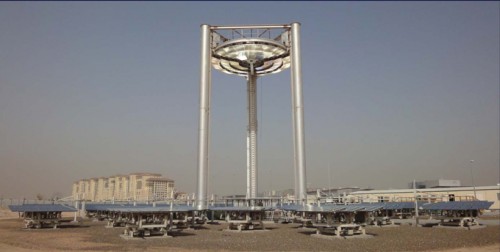
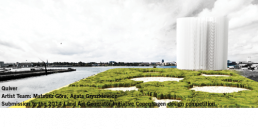
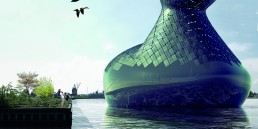
[…] Subscribe to feed ‹ The Solar Hourglass […]
[…] The Solar Hourglass […]